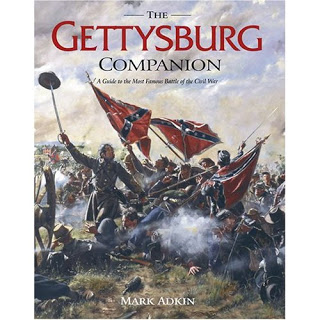Solitamente gli appassionati di simulazione storica si possono dividere in due grandi categorie: quelli che giocano “per giocare”, cio? coloro che forse non sanno neppure cosa stanno ricreando ma utilizzano al meglio il gioco ( e sono i pi? temibili!) e quelli che sono “esperti” del periodo storico che il gioco riproduce, che sanno dirti …quella pedina rappresenta il 3? battaglione, 1a divisione,… ecc.
Per questi ultimi, il piacere di utilizzare giochi per ricreare al meglio la realt? storica v? di pari passo con il piacere di acquistare un buon libro sull’argomento che interessa.
In questa pagina cercheremo di segnalare alcuni titoli (vecchi e nuovi), molto interessanti per l’hobby della simulazione; allo stesso modo segnaleremo riviste specializzate nel settore delle simulazioni.
 |
Dopo Waterloo e Trafalgar Companion, ecco il terzo enorme e ottimo lavoro di Mark Adkin sulla pi? famosa battaglia americana, Gettysburg. Libro eccezionale, come i primi due, indispensabile per chiunque sia appassionato del periodo, oltre che della battaglia! Dal sito:? http://civilwarlibrarian.blogspot.com/2008/10/cwl-new-gettysburg-companion-gem-with.html The Gettysburg Companion: A Guide to the Most Famous Battle of the Civil War Mark Adkin Scott Hartwig, supervisory historian of Gettysburg National Military Park, states on the front inside flap of the cover, that “This is the Gettysburg book that students and aficionados of the battle have dreamed about . . . . The Gettysburg Campanion is quite absolute gem.” So it appears but CWL sees that many of the books strengths are also its weaknesses. Open the book at page 429: There is a nice modern color photograph taken six feet above the ground of the terrain over which ‘Kershaw’s Brigade Attacks From the Millerstown Road’. The Millerstown Road is on the horizon not the foreground or so it appears from the title of the photograph. On the photograph are the key sites: Rose Farm and Biesecker’s Woods in the distance; three orange arrows flow from the horizon and over the ground showing the path of Confederate troops towards the photographer. The photograph looks sharp and the graphics are crisp. The problem is that the author does not show on a map the position on the battlefield where the photographer stood. Though in the caption a description is given regarding the the photographer’s position as being from the position of Bigelow’s battery. If that is the case and it does appear so, then the title of the photograph is wrong. Kemper does not attack from the Millerstown (Wheatfield) Road but towards the Millerstown Road. Now turn to panorama photographs on page 434 and 435. ‘The View from Bigelow’s Final Battery Position Looking Toward the Rebel Attack’. In this case the title matches the position of the photographer and the movement of the Confederate troops. CWL sees that Akins should have asked Stackpole Publishing for a few sharp-eyed, licensed battlefield guides to actually read everything in the book. Adkin has invested a major effort into The Gettysburg Companion but he leaves CWL grasping in vain for explicit guideposts for the sources he consulted. CWL also has complaints that the citations are inadequate for convenient source checking. The bibliography of consulted sources is too small to substantiate the immense amount of material the author discusses. This leads CWL to consider the charges which J.D. Petruzzi levels in his Amazon.com review and his remarks on online The Gettysburg Discussion Group forum against Gettysburg Companion; specific quotations were used from diary and letter sources that can be found only in others scholarship. Also, Petruzzi states that the William Frassinito, acknowledged as the expert on Gettysburg photography, quickly found misidentified illustrations. It appears that Adkin is a subscriber to both North and South Magazine and Gettysburg Magazine. In the acknowledgments, Adkin thanks Tom Desjardins and the Friends of the National Parks at Gettysburg for allowing him to use their map as a base from which he adds enhancements. Yet it appears that some information is taken from North and South Magazine and Gettysburg Magazine without attribution. As enjoyable as The Gettysburg Companion can be, CWL winces at the lapse of acknowledgement by Adkin of the many, many historians who have mined primary sources and published their work with bibliographic citations. If Gettysburg Companion is intended to be a coffee table book which looks nice on display and a satisfying book through which to browse, then the meager citations are not an issue. But if Adkin hoped his work would stand alongside the work of scholars, then the Gettysburg Companion will not be on the bookshelf but stay on the coffee table. Inutile ricordare l’ottimo libro di Raimondo Luraghi, che tratta tutta la guerra civile americana: http://libreriarizzoli.corriere.it/libro/luraghi_raimondo-storia_della_guerra_civile_americana.aspx?ean=9788817028707, indispensabile per uno studio generale sul periodo. |
| Euro 54,00 | Stackpole Books |

